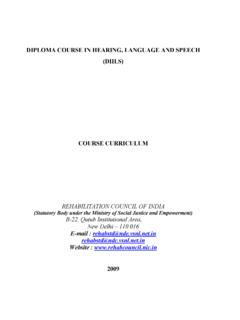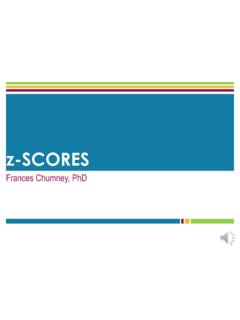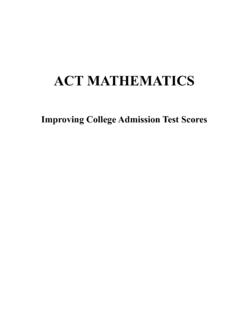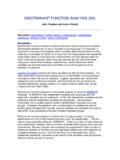Transcription of HEARING IMPAIRMENT
1 HEARING . IMPAIRMENT . Chapter 1. Introduction The Ear and Its Work damage to the inner ear, makes it difficult to tolerate T he sense of HEARING provides a background, loud sounds. which gives a feeling of security and For children with HEARING IMPAIRMENT , participation in life. It plays a critical role in the congenital or acquired before development of development of speech and language and in speech and language, normal speech development monitoring one's speech. is interfered with. The ear is a complex, but delicate structure With unilateral HEARING IMPAIRMENT also, designed to perform a variety of functions: to able there is difficulty in localizing sound, reduced to hear very soft sounds over a wide frequency speech discrimination. Lower speech and language range as well as withstand the very loud sounds, to development in children has significant effect on discriminate between sounds that vary in pitch and their educational, linguistic and auditory perceptual loudness; to be able to locate the direction of arrival development.
2 Of a sound and in the presence of noise, to be able to switch on and off a sound of interest. The HEARING -impaired persons have in common, their difficulty in HEARING spoken and The human ear perceives simple tones in the other sounds. They also depend on what they see range of 20 to 20,000 Hz and also complex signals which they supplement to what they hear. such as speech and music. Both types of signals are used in the assessment of HEARING loss. Assessment HEARING sensitivity of each ear is Impact of HEARING IMPAIRMENT measured separately and the severity/degree of Consequences of HEARING IMPAIRMENT will HEARING IMPAIRMENT / HEARING loss is generally depend on the ear/s involved, the degree and the classified in seven categories as per Goodman's type of HEARING loss and the age of onset. (1965) classification and an additional category HEARING IMPAIRMENT leads to loss of normal - slight HEARING loss is added between the verbal communication.
3 Due to distortion of normal HEARING and mild HEARING loss sounds, differentiation of environmental sounds, especially when assessing the HEARING including speech, is difficult; making sounds sensitivity of young children. Table 1 shows louder does not improve the clarity or quality of the classification of severity of HEARING sound. Similarly, recruitment, which is an IMPAIRMENT . abnormal growth in loudness, a characteristic of 99. Table 1: Classification of Severity of Percentage of HEARING Disability HEARING IMPAIRMENT (Threshold + Speech Discrimination Score Based). Classification PTA range in dBHL The Ministry of Social Justice and Normal HEARING -10 to 15 Empowerment, Government of India notified Slight HEARING Loss 16 to 25 guidelines for evaluation of various disabilities and Mild HEARING Loss 26 to 45. procedure for certification vide Notification No.
4 Moderate HEARING Loss 46 to 55. 16-18/97-NI dated 1st June 2001. Procedure for calculating HEARING disability is based on pure tone Moderately-severe HEARING Loss 56 to 70. thresholds as well as speech discrimination score Severe HEARING Loss 71 to 90. in order to arrive at the percentage of the disability. Profound HEARING Loss 91 and more The minimum degree of disability should be 40%. in order to be eligible for any concessions/ benefits. The level of normal conversational speech is approximately 65dBSPL. Thus, for a person with Issue of Disability Certificate HEARING IMPAIRMENT of 60dBHL or more, verbal The certificate of disability is to be issued by communication would be difficult. This level of a medical board consisting of at least three HEARING IMPAIRMENT has been equated as 40%. members, of which one shall be an HEARING IMPAIRMENT as in Persons with Disability otolaryngologist.
5 Percentage of disability can be (Full Participation, Equal Opportunity and determined considering Pure Tone Average and Protection of Rights) Act, 1995. The definition of Speech Discrimination Score as shown in Table 2. HEARING disabled as stipulated in the PWD Act, 1995. is a person who has a minimum of 60dBHL of HEARING IMPAIRMENT in the better ear in speech conversation frequencies. Table 2: Percentage of Disability Category Type of PTA of Better Speech Discrimination Percentage IMPAIRMENT Ear in dBHL Score of Better Ear of Disability I Mild 26-40 80-100% < 40%. II(a) Moderate 41-60 50-80% 40-50%. II(b) Severe 61-70 40-50% 51-70%. III(a) Profound 71-90 <40% 71-100%. III(b) Total >91 Very Poor 100%. To obtain Speech Discrimination scores, nor standardized tests for speech discrimination in specialized skills, instruments and standardized various languages are presently available in all tests are required.
6 Neither the range of instruments centers in the country. 100. Chapter 2. Historical Perspective H istorical developments have been dealt with comprehensively in the Disability Status Reports published by the RCI, in 2001 and 2003. mean that any effort to initiate early intervention services should be accompanied by short term training programs for qualified professionals. Since then, significant events such as establishment These programs should be aimed at equipping and support of early identification and early rehabilitation professionals to handle aspects intervention centers by the AYJNIHH, Mumbai especially pertinent to very young children. and the Disability Helpline initiated during 2004- Keeping these issues in view, the project was 05 are worthy of mention. evolved. The project was conceptualized in two phases: Establishment of Early Intervention Phase I: Training of manpower to enable Centers and Training of Personnel them to handle very young A collaborative project by AYJNIHH, children.
7 Mumbai and Balavidyalaya, Chennai on Early Identification and Early Intervention towards Phase II: Running the early intervention Inclusive Education of Children with HEARING programs. IMPAIRMENT (0 to 5 years)' was initiated in 2002. Under the project, it was decided that a one- An urgent need was felt to lower the age of month orientation program would be given to identification of HEARING IMPAIRMENT and already qualified professionals to work with strengthen intervention service delivery. If a larger children in the age range of 0 to 5 years. Seven number of children with HEARING IMPAIRMENT centers were chosen to run the project, namely acquire abilities ensuring their success in AYJNIHH, Mumbai; its four regional centers at mainstream education, they pave the way for more Secunderabad, Delhi, Bhubaneshwar and Kolkata;. severely affected children to avail the services of Balavidyalaya, Chennai and NISH, Trivandrum.
8 Special schools. The gains shown by children who A training package with curriculum specified, video have gone through the process of early intervention films and manual was evolved. The uniformity of in India were convincing enough to start a greater execution across centers was ensured through a number of early intervention programs on a pilot project basis. However, the diploma and degree program for Training of Trainers (TOT). Two courses in special education do not focus enough representatives from each of the seven centers on aspects of habilitation with very young children attended the TOT program. Each center was with the exception of the Diploma in Training directed to periodically conduct one month Young HEARING Impaired Children which is orientation programs with an aim to have at least 5. available only in three centers in India. This would per year with ten trainees per batch.
9 Special schools 101. already running programs for pre-school children Disability Helpline and institutions conducting diploma and degree Frequently due to lack of awareness among courses in special education were approached and the persons with disabilities and the community, encouraged to depute professionals/suggest the early identification and rehabilitation processes candidates from among past students of degree and are delayed. Also the benefits of services offered diploma courses. Interested fresh and or by Government and Non-Government unemployed special educators were also enrolled. organizations for the rehabilitation of persons may The seven centers under the project were not be availed of by the target group on account already providing diagnostic and or intervention of lack of information. The Disability Line services for children in the 0 to 5 year age group.
10 Launched by AYJNIHH, Mumbai in 2005 was Thus it was decided that for the second phase, it envisaged to bridge this gap to some extent by would be ideal to run the intervention programs enabling the public to have easy access to under close supervision of these centers. Each of information regarding disabilities, the services the centers could appoint a teacher/speech- available in their neighborhood as well as the language pathologist and audiologist who had schemes and concessions offered by the undergone the one month orientation program. If Government. a center had more than 25 children, two teachers Specifically, the Disability Line provides could be employed. The center could also appoint information about: two ayahs/helpers. Until now, the focus was on the Different types of disabilities. 0 to year age group. This was reflected in the orientation programs as well which focused only Diagnosis and intervention strategies.
















